justin's diversity helps spread risk
advertisement
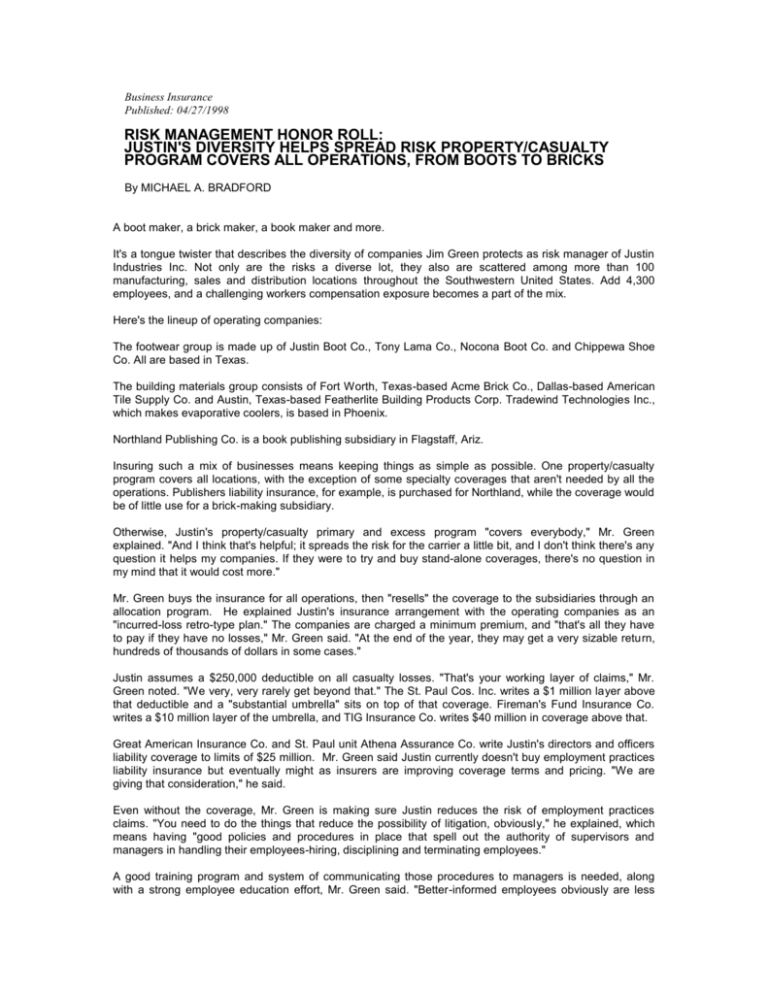
Business Insurance Published: 04/27/1998 RISK MANAGEMENT HONOR ROLL: JUSTIN'S DIVERSITY HELPS SPREAD RISK PROPERTY/CASUALTY PROGRAM COVERS ALL OPERATIONS, FROM BOOTS TO BRICKS By MICHAEL A. BRADFORD A boot maker, a brick maker, a book maker and more. It's a tongue twister that describes the diversity of companies Jim Green protects as risk manager of Justin Industries Inc. Not only are the risks a diverse lot, they also are scattered among more than 100 manufacturing, sales and distribution locations throughout the Southwestern United States. Add 4,300 employees, and a challenging workers compensation exposure becomes a part of the mix. Here's the lineup of operating companies: The footwear group is made up of Justin Boot Co., Tony Lama Co., Nocona Boot Co. and Chippewa Shoe Co. All are based in Texas. The building materials group consists of Fort Worth, Texas-based Acme Brick Co., Dallas-based American Tile Supply Co. and Austin, Texas-based Featherlite Building Products Corp. Tradewind Technologies Inc., which makes evaporative coolers, is based in Phoenix. Northland Publishing Co. is a book publishing subsidiary in Flagstaff, Ariz. Insuring such a mix of businesses means keeping things as simple as possible. One property/casualty program covers all locations, with the exception of some specialty coverages that aren't needed by all the operations. Publishers liability insurance, for example, is purchased for Northland, while the coverage would be of little use for a brick-making subsidiary. Otherwise, Justin's property/casualty primary and excess program "covers everybody," Mr. Green explained. "And I think that's helpful; it spreads the risk for the carrier a little bit, and I don't think there's any question it helps my companies. If they were to try and buy stand-alone coverages, there's no question in my mind that it would cost more." Mr. Green buys the insurance for all operations, then "resells" the coverage to the subsidiaries through an allocation program. He explained Justin's insurance arrangement with the operating companies as an "incurred-loss retro-type plan." The companies are charged a minimum premium, and "that's all they have to pay if they have no losses," Mr. Green said. "At the end of the year, they may get a very sizable return, hundreds of thousands of dollars in some cases." Justin assumes a $250,000 deductible on all casualty losses. "That's your working layer of claims," Mr. Green noted. "We very, very rarely get beyond that." The St. Paul Cos. Inc. writes a $1 million layer above that deductible and a "substantial umbrella" sits on top of that coverage. Fireman's Fund Insurance Co. writes a $10 million layer of the umbrella, and TIG Insurance Co. writes $40 million in coverage above that. Great American Insurance Co. and St. Paul unit Athena Assurance Co. write Justin's directors and officers liability coverage to limits of $25 million. Mr. Green said Justin currently doesn't buy employment practices liability insurance but eventually might as insurers are improving coverage terms and pricing. "We are giving that consideration," he said. Even without the coverage, Mr. Green is making sure Justin reduces the risk of employment practices claims. "You need to do the things that reduce the possibility of litigation, obviously," he explained, which means having "good policies and procedures in place that spell out the authority of supervisors and managers in handling their employees-hiring, disciplining and terminating employees." A good training program and system of communicating those procedures to managers is needed, along with a strong employee education effort, Mr. Green said. "Better-informed employees obviously are less likely to be ones to cause problems for you." Employment practices liability is a tricky exposure, he said. Like product liability, "it's a moving target. What's expected of you today may not be enough tomorrow because of some court case somewhere." To stay on top of that exposure, Mr. Green attends at least two employment law seminars each year, subscribes to newsletters that cover the topic and uses the Internet to research employment law issues. That effort is necessary, he said, because "it's fertile ground out there for the plaintiffs' lawyers." Most of Justin's primary property/casualty coverages are placed by El Paso, Texas-based Rogers & Belding Insurance Agency Inc. The Brants Co., a Fort Worth, Texas, broker, places D&O, excess layers and specialty coverages. Justin's workers comp program is a large-deductible plan, with St. Paul writing statutory limits excess of a $250,000 deductible. At times, Mr. Green has worked with brokers and insurers to develop specialty coverages. Before Justin sold a subsidiary that made ceramic cooling towers, Mr. Green realized a need for a coverage that would pay to retrofit the units if they failed to meet contracted performance standards. Cooling towers are used in a variety of settings, from office buildings to nuclear power plants, to cool air with circulated water. American International Group Inc. developed an insurance product specifically for that risk. "It didn't have the word 'warranty' in it, but it pretty much was," Mr. Green noted. Justin bought the coverage for five years and collected about $5 million on one claim to retrofit a tower at a Utah nuclear power plant. Considering the amount o f premium paid for the coverage and the cost of the repairs, Justin realized about a $2 million savings, Mr. Green said. On the property side, Wausau Insurance Cos. has written Justin's coverages for the past three years. The highly protected risk program includes a $25,000 deductible. "It's a blanket policy covering all our locations," Mr. Green said. Justin's operations span eight states, with around 100 manufacturing, sales and distribution facilities. The properties are valued at about $330 million. Mr. Green pointed out that the company's insurers not only write coverage but also serve as a resource to help make Justin's operations safer. Wausau, for example, sends representatives to Justin's 35 manufacturing facilities once a year. "They do a report that comes to me. We keep those on file and send them out to the locations from here." The reports often contain recommendations intended to improve safety and reduce losses. "We get some feedback from our managers on getting those recommendations implemented," Mr. Green said. "We do the same thing with our casualty lines," he added. The casualty insurers' representatives usually visit the plants twice a year to do a "safety walk-through," meet with plant managers and participate in safety training programs. Mr. Green's work to protect Justin's assets has impressed his boss. "His knowledge of the insurance industry and the insurance markets could be his biggest strength," said Richard J. Savitz, Justin Industries' chief financial officer and the man to whom Mr. Green reports. "He's always on top of everything that's going on." Mr. Savitz said his risk manager "needs little or no supervision. I trust he is constantly working on ways to do his job better, to protect the company." Copyright Crain Communications Inc. Reproduced with permission of the Publisher.
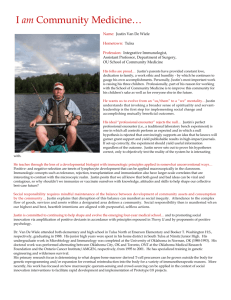


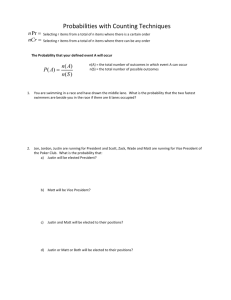
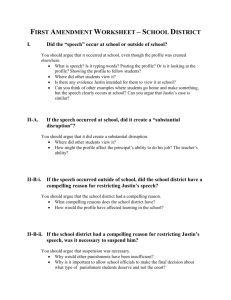

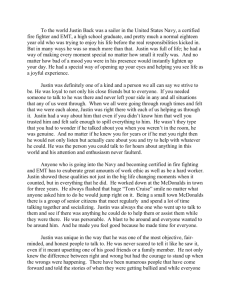
![The Irony of Love (122) [by Proud 86].](http://s3.studylib.net/store/data/007306595_1-aca9830606a408d7bdeb2a12d7258405-300x300.png)
